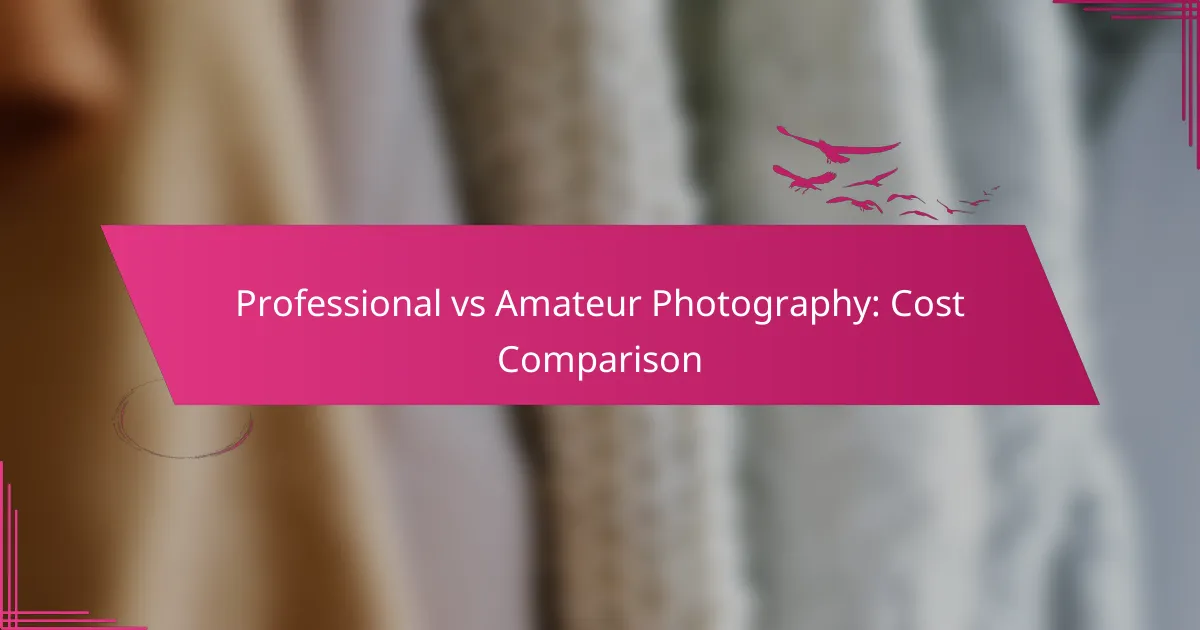When comparing professional and amateur photography, the cost differences are notable and influenced by various factors such as equipment quality and expertise. Professional photographers often charge significantly more due to their investment in high-end gear and extensive experience, while amateur photographers may operate with lower costs but also varying levels of skill and equipment. Understanding these distinctions can help clients make informed decisions based on their budget and photography needs.
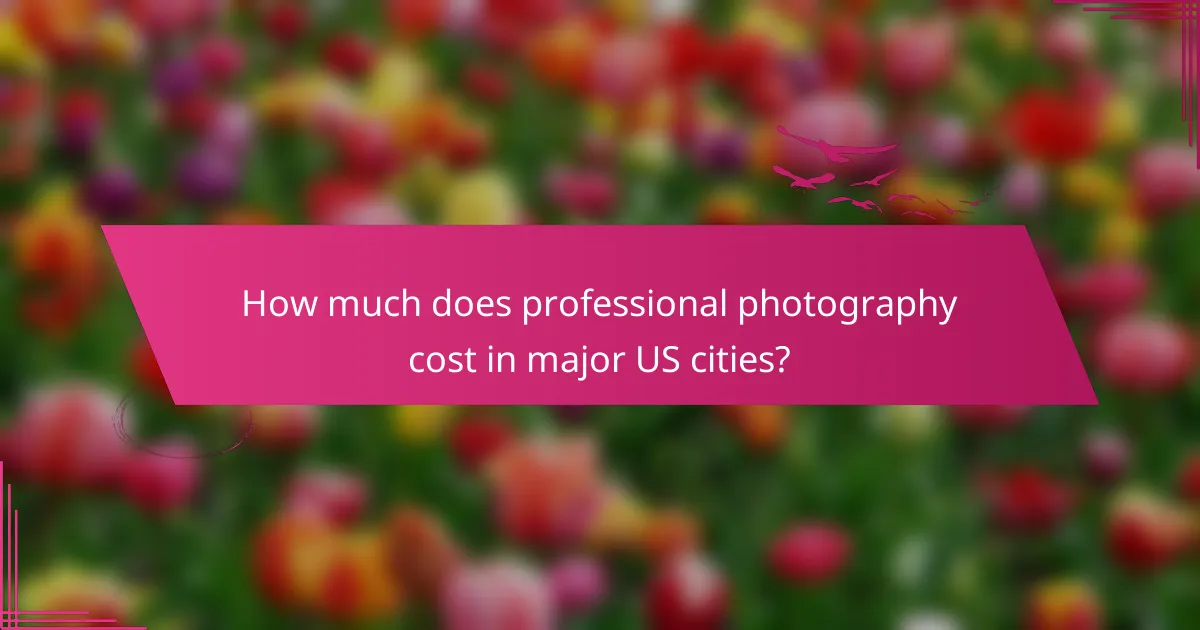
How much does professional photography cost in major US cities?
Professional photography costs can vary significantly across major US cities, influenced by factors such as demand, experience, and the type of photography service required. Generally, clients can expect to pay anywhere from a few hundred to several thousand dollars depending on the specifics of their project.
Average rates in New York City
In New York City, professional photography rates typically range from $300 to $3,000 per session. Factors such as the photographer’s reputation, the complexity of the shoot, and the duration can all affect pricing.
For example, a basic portrait session may cost around $500, while a full-day wedding shoot could exceed $2,500. It’s advisable to review portfolios and client testimonials to ensure quality aligns with pricing.
Average rates in Los Angeles
Los Angeles sees professional photography rates from approximately $250 to $2,500. The city’s vibrant entertainment industry often drives higher prices, especially for commercial and fashion photography.
A simple headshot session might start at $300, whereas a comprehensive advertising campaign could demand upwards of $2,000. Clients should consider the photographer’s niche and expertise when evaluating costs.
Average rates in Chicago
In Chicago, clients can expect to pay between $200 and $2,000 for professional photography services. The rates can vary based on the type of photography, such as real estate, events, or portraits.
A standard family portrait session may be priced around $400, while a corporate event shoot could range from $1,000 to $1,500. It’s beneficial to compare multiple photographers to find the best fit for your budget and needs.
Average rates in Miami
Miami’s professional photography costs generally fall between $250 and $2,000. The local market often reflects the city’s tourism and event-driven economy, influencing rates for services like weddings and commercial shoots.
For instance, a beach wedding photography package might start at $1,200, while a basic portrait session could be around $300. Always check for packages that may offer better value for comprehensive services.
Average rates in San Francisco
In San Francisco, professional photography rates typically range from $300 to $3,000. The tech industry’s presence can lead to higher demand for corporate photography, which may impact pricing.
A basic engagement session might cost about $600, whereas a full-day event shoot could reach $2,500 or more. Clients should prioritize finding photographers who understand their vision and can deliver quality work within their budget.
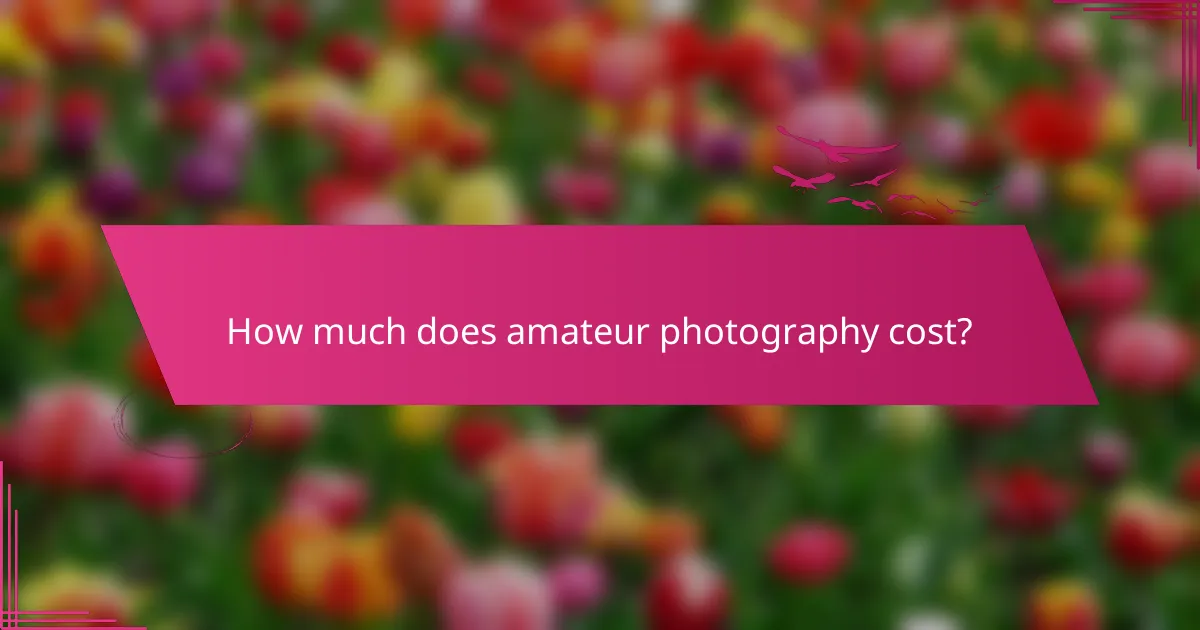
How much does amateur photography cost?
The cost of amateur photography can vary widely, typically ranging from a few hundred to a couple of thousand dollars depending on the equipment, software, and educational resources chosen. Beginners should consider these expenses carefully to ensure they invest wisely in their photography journey.
Equipment costs for beginners
For beginners, the initial equipment costs can start as low as $200 for a basic camera and lens setup. However, many enthusiasts opt for mid-range options that can cost between $500 and $1,500, which often include better lenses and accessories like tripods and bags.
When selecting equipment, consider the type of photography you want to pursue. For instance, a DSLR or mirrorless camera is versatile for various styles, while specialized gear like macro lenses or drones can increase costs significantly. Always factor in the potential need for additional accessories, which can add another few hundred dollars to your budget.
Editing software expenses
Editing software is essential for enhancing photos, with options ranging from free programs like GIMP to subscription-based services like Adobe Lightroom and Photoshop, which can cost around $10 to $20 per month. Many amateurs start with free or low-cost software to learn basic editing skills before investing in more advanced tools.
It’s important to choose software that fits your editing needs and budget. Look for trial versions to test functionality before committing to a purchase. Additionally, consider the long-term costs associated with software subscriptions, as they can add up over time.
Cost of online courses
Online photography courses can range from free tutorials to comprehensive programs costing several hundred dollars. Many platforms offer courses priced between $50 and $300, depending on the depth of content and the instructor’s expertise.
When selecting a course, look for those that offer practical assignments and feedback, as these can significantly enhance your learning experience. Free resources, such as YouTube channels and photography blogs, can also provide valuable information without any financial commitment.
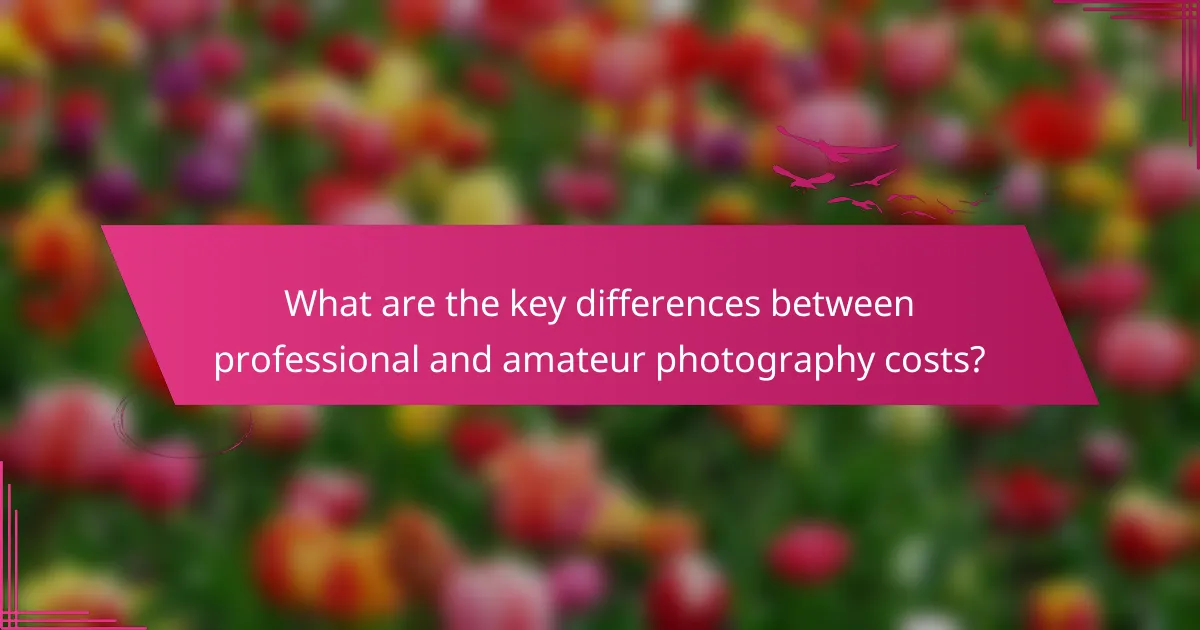
What are the key differences between professional and amateur photography costs?
The costs associated with professional and amateur photography differ significantly, primarily due to the quality of equipment, service pricing structures, and market demand. Professionals typically invest more in high-end gear and charge for their expertise, while amateurs often rely on less expensive equipment and may not have formal pricing strategies.
Equipment quality comparison
Professional photographers usually use high-quality cameras, lenses, and lighting equipment, which can cost thousands of dollars. In contrast, amateur photographers often utilize entry-level gear or smartphones, which are more affordable but may not deliver the same image quality. This difference in equipment directly influences the overall cost of photography services.
For example, a professional camera setup might range from $2,000 to $10,000, while an amateur might spend between $300 and $1,500 on their gear. This disparity affects not only the initial investment but also the longevity and performance of the equipment used in shoots.
Service pricing structures
Professional photographers typically charge based on their experience, skill level, and the complexity of the project. Prices can vary widely, often ranging from $100 to $500 per hour or more, depending on the service provided. Amateurs, on the other hand, may offer lower rates or even free services to build their portfolios, which can make them appealing for budget-conscious clients.
When hiring a photographer, consider what is included in the price. Professionals often provide detailed contracts, editing services, and high-resolution images, while amateurs may not offer the same level of service or post-processing.
Market demand impacts
Market demand plays a crucial role in determining photography costs. In areas with high demand for professional photography, such as major cities, prices can be significantly higher due to competition and the need for quality. Conversely, in smaller towns or regions with less demand, both professional and amateur photographers may lower their prices to attract clients.
Additionally, trends in photography, such as the popularity of social media, can influence demand. For instance, during wedding season, professional photographers may raise their rates due to increased bookings, while amateurs might see a surge in requests for casual shoots.
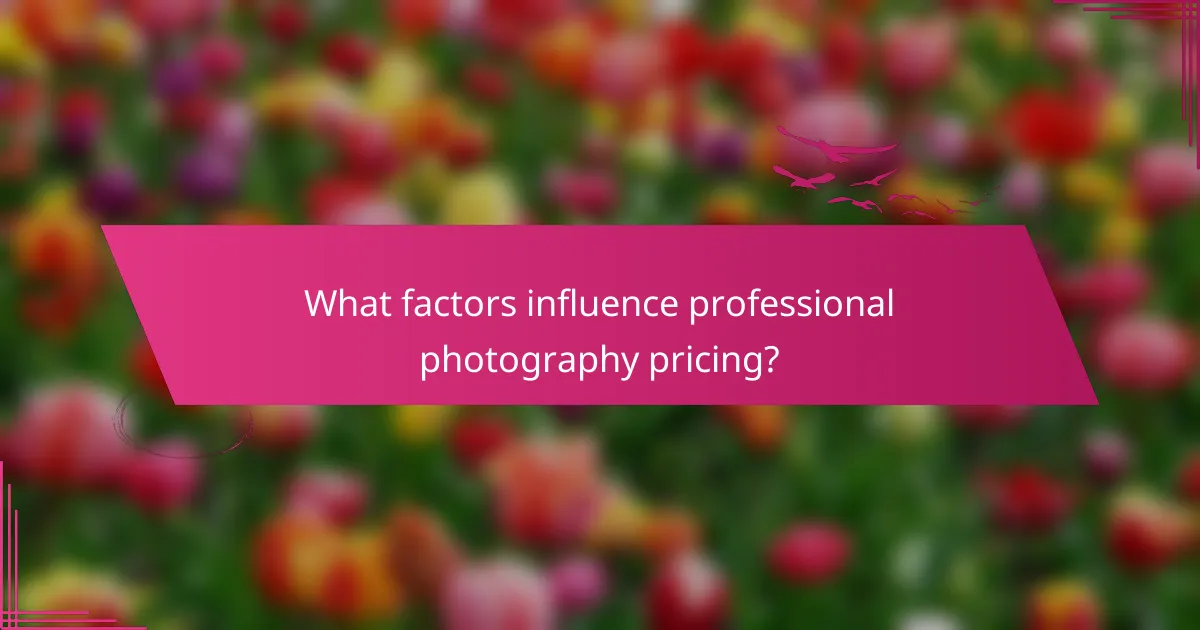
What factors influence professional photography pricing?
Professional photography pricing is influenced by several key factors, including the photographer’s experience, the type of photography service provided, and any location-related expenses. Understanding these elements can help clients make informed decisions when hiring a photographer.
Experience level of the photographer
The experience level of a photographer significantly impacts their pricing. Generally, seasoned professionals with extensive portfolios charge higher rates due to their expertise and proven track record. In contrast, amateur photographers may offer lower prices as they build their skills and client base.
For example, a well-established photographer might charge several hundred to over a thousand USD for a session, while an amateur might offer similar services for a fraction of that cost. Clients should weigh the value of experience against their budget when selecting a photographer.
Type of photography service offered
The type of photography service can greatly affect pricing. Different genres, such as wedding photography, commercial shoots, or portrait sessions, come with varying levels of complexity and required equipment. For instance, wedding photography typically demands more time and resources, leading to higher fees.
On average, clients can expect to pay anywhere from a few hundred to several thousand USD depending on the service. It’s essential to clarify what is included in the package, such as editing, prints, or travel, to avoid unexpected costs.
Location and travel expenses
Location plays a crucial role in determining photography costs. Photographers based in urban areas often charge more due to higher living expenses and demand. Additionally, if a shoot requires travel, this can add to the overall price, as many photographers include travel fees in their quotes.
For example, a photographer might charge a standard rate for local sessions but add a travel fee for locations outside a certain radius. Clients should discuss potential travel costs upfront to ensure their budget accommodates these expenses.

What are the benefits of hiring a professional photographer?
Hiring a professional photographer offers several advantages, including superior quality, access to advanced tools, and expert editing services. These benefits can significantly enhance the overall outcome of your photography needs, whether for personal or commercial purposes.
Quality of work
Professional photographers are trained to deliver high-quality images that meet industry standards. Their expertise allows them to capture moments with precision, ensuring that lighting, composition, and focus are all optimized.
In contrast, amateur photographers may lack the skills and experience necessary to produce consistently excellent results. This difference can be particularly noticeable in important events like weddings or corporate functions where quality is paramount.
Access to advanced equipment
Professional photographers typically invest in high-end cameras, lenses, and lighting equipment that amateurs may not have access to. This advanced gear allows for greater versatility and the ability to shoot in various conditions, from low light to fast action.
For example, a professional might use a full-frame camera with a range of specialized lenses to achieve stunning depth of field and clarity, which can elevate the overall aesthetic of the photographs.
Professional editing services
Another significant benefit of hiring a professional is their ability to provide expert editing services. After the shoot, professionals use advanced software to enhance images, correct colors, and retouch imperfections, resulting in polished final products.
Amateur photographers may lack the skills or software to perform effective editing, which can lead to subpar images. Professional editing can transform good photos into exceptional ones, making them suitable for print or online use.
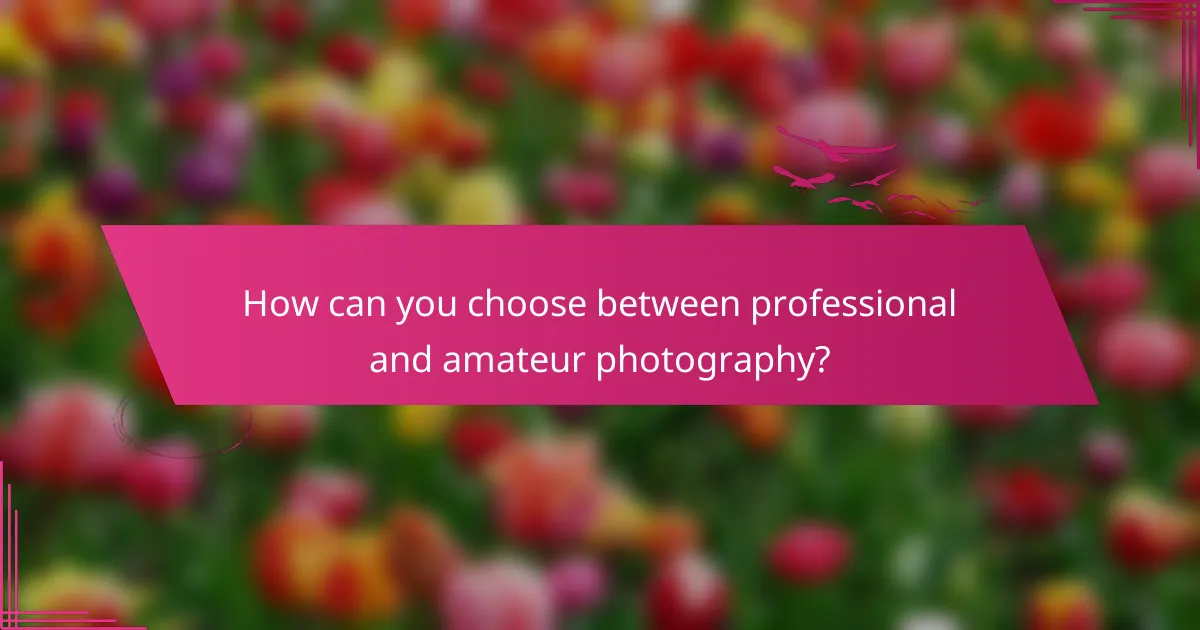
How can you choose between professional and amateur photography?
Choosing between professional and amateur photography depends on your specific needs, budget, and the desired quality of the final images. Professionals typically offer higher quality and experience, while amateurs may provide more affordable options but with varying results.
Assessing project requirements
Start by clearly defining the goals of your photography project. Consider factors such as the purpose of the images, the intended audience, and the style you envision. For instance, a corporate event may necessitate a professional photographer to ensure high-quality branding images, while a casual family gathering might be well-suited for an amateur.
Next, evaluate the complexity of the project. If it involves intricate details, specialized equipment, or specific lighting conditions, a professional’s expertise can be invaluable. On the other hand, simpler projects may not require a professional’s skills, allowing you to save on costs.
Finally, think about your budget. Professional photography can range from hundreds to thousands of dollars, depending on the photographer’s experience and the project’s scope. Amateurs may charge significantly less, but weigh the potential trade-offs in quality and reliability before making a decision.
